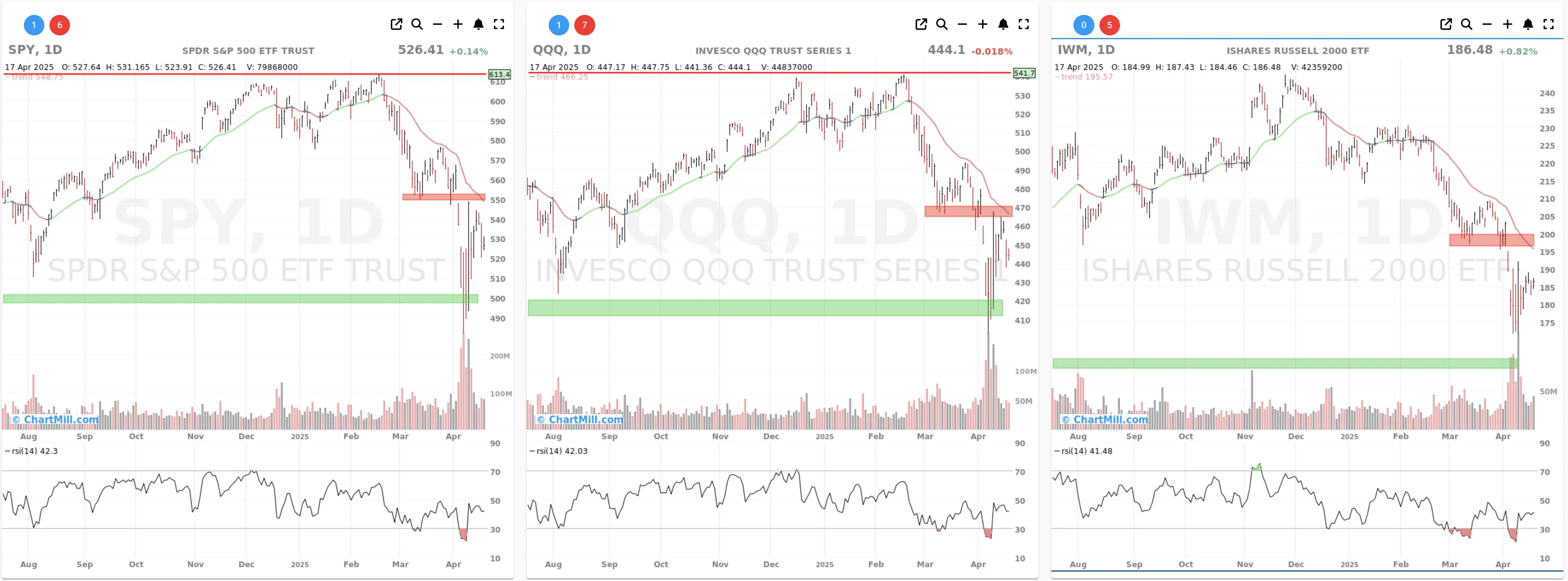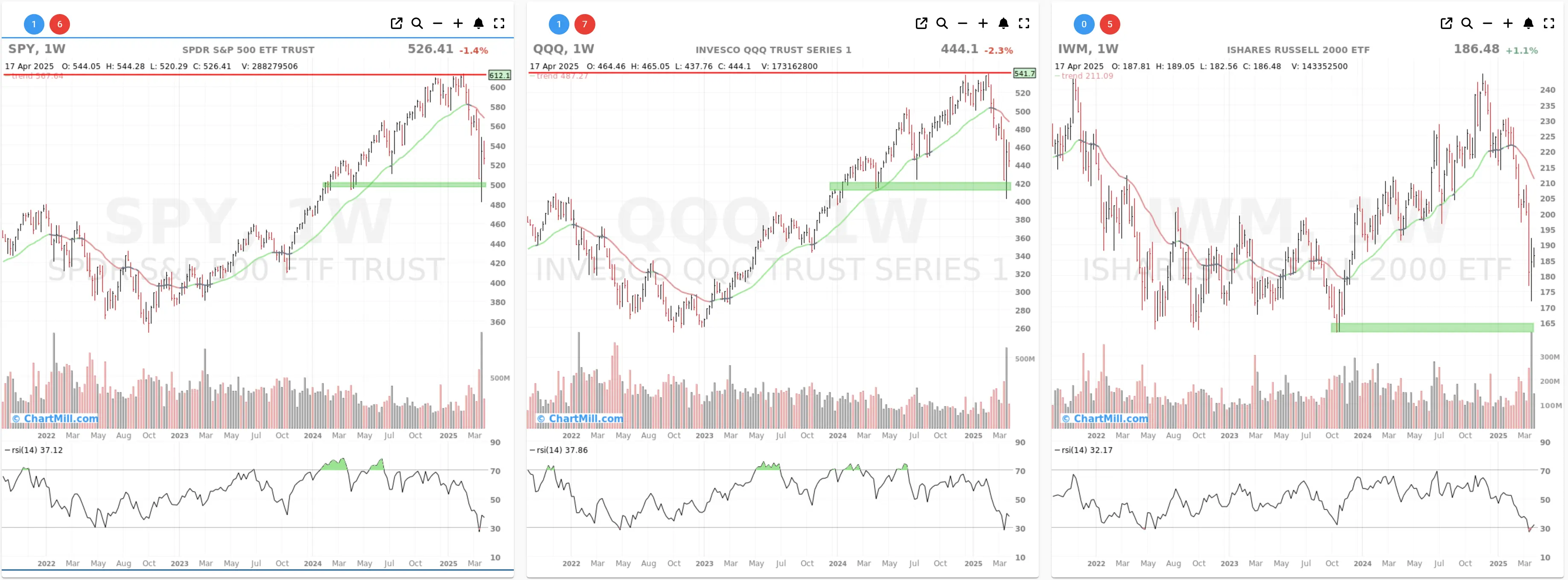Market Monitor April 18 ( Eli Lilly, Netflix UP, United Health Group, Manpower DOWN)
By Kristoff De Turck - reviewed by Aldwin Keppens
Last update: Apr 18, 2025

Wall Street Mostly Lower Amid Trump-Fed Tensions, Nvidia’s Continued Slide
U.S. markets mostly declined Thursday, weighed down by ongoing tensions between President Trump and Federal Reserve Chair Jerome Powell, alongside persistent weakness in tech giant Nvidia (NVDA | -2.9%). The Dow Jones dropped 1.3%, dragged by a steep 22% loss for UnitedHealth Group (UNH | -22.4%), which reported disappointing earnings and lowered its outlook due to Medicare-related challenges.
The S&P 500 edged up slightly by 0.1%, while the Nasdaq closed marginally lower (-0.1%).
Markets came under pressure after Powell reiterated caution over recent tariff-induced inflation, emphasizing stability in long-term inflation expectations. Trump's criticism intensified, demanding immediate rate cuts and openly calling for Powell’s dismissal, adding further uncertainty to already nervous markets.
Economic data also disappointed, with the Philadelphia Fed manufacturing index plunging unexpectedly into contraction territory, marking its lowest level since April 2023. Housing starts also declined more sharply than anticipated, although building permits rose.
In corporate news, chipmaker Nvidia fell another 3%, extending losses after warning of a $5.5 billion hit due to new export restrictions to China. AMD (AMD | -0.9%) slipped 1% following similar export licensing challenges.
On the upside, pharmaceutical giant Eli Lilly (LLY | +14.3%) surged 14% after reporting positive trial results for its new diabetes and weight-loss drug, while staffing company Manpower (MAN | -19.0%) plunged 19% on weak quarterly results. Aluminum producer Alcoa (AAL | -7.0%) lost 7% as tariffs weighed on earnings.
Oil prices jumped 3.5%, driven by tighter supply concerns amid new U.S. sanctions on Iranian oil exports and planned OPEC production cuts. Meanwhile, Netflix (NFLX | +1.19%) gained 4% in after-hours trading, impressing investors with strong growth and improved margins due to recent price increases.
U.S. Treasury yields rose slightly, and the euro weakened against the dollar, closing at 1.1372.
Daily Market Analysis – April 17, 2025 (After Market Close)
Short Term Trend

- Short-Term Trend: Down (no change)
- Support at $500
- Resistance at $550
- Volume: slightly above average (50)
- Pattern: Inside Day
- Short-Term Trend: Down (no change)
- Support at $415
- Resistance at $466
- Volume: slightly below average (50)
- Pattern: Inside Day
- Short-Term Trend: Down (no change)
- Support at $170
- Resistance at $197
- Volume: slightly above average (50)
- Pattern: Bullish Engulfing
Long Term Trend

- Long-Term Trend: Down (no change)
- Long-Term Trend: Down (no change)
- Long-Term Trend: Down (no change)
Market Breadth Analysis for April 17, 2025 (After Market Close)

1. Market Sentiment: Sharp Bullish Bounce Back
-
April 17 showed a significant bullish rebound with 71.3% advancing stocks versus only 26.5% declining.
-
This marks a rapid turnaround from the prior day (April 16), when only 32.3% stocks advanced, indicating short-term volatility and uncertainty.
2. Momentum Indicators: Improving Positive Momentum
-
Advancing Stocks +4% rose to 4.5% (from 2.9% previously), showing increased bullish momentum.
-
Declining Stocks -4% sharply reduced to 1.1%, indicating a clear reduction in selling pressure compared to the previous day (4.5%).
3. Internal Market Strength: Slight Improvement but Still Weak
Stocks above their key Moving Averages (SMAs) slightly increased but remain at historically low levels:
-
Above SMA(20): rose to 26.7%
-
Above SMA(50): increased slightly to 18.1%
-
Above SMA(100): improved to 18.7%
-
Above SMA(200): slightly higher at 20.2%
This suggests a mild improvement in internal market conditions, though broad-based strength is still lacking.
4. New Highs/New Lows & Trend Strength
-
New Highs (NH) remain minimal at 0.6%, indicating limited market leadership.
-
New Lows (NL) dropped to 1.5% (previously 2.2%), suggesting slightly reduced weakness.
-
Percent Positive (PP) remains low at 2.8%, signifying continued overall market weakness.
Conclusion & Outlook
The latest breadth data indicates a strong one-day bullish recovery, signaling potential short-term relief. However, internal strength remains low, and longer-term trends are still bearish, suggesting caution.
Sustained improvement in stocks trading above key moving averages and increased new highs will be critical to confirming a meaningful trend reversal.
23.32
-1.75 (-6.98%)
839.96
+105.06 (+14.3%)
454.11
-130.93 (-22.38%)
973.03
+11.4 (+1.19%)
40.07
-9.44 (-19.07%)
87.5
-0.79 (-0.89%)
101.49
-3 (-2.87%)
Find more stocks in the Stock Screener
AA Latest News and Analysis
 5 hours ago - ChartmillMarket Monitor April 18 ( Eli Lilly, Netflix UP, United Health Group, Manpower DOWN)
5 hours ago - ChartmillMarket Monitor April 18 ( Eli Lilly, Netflix UP, United Health Group, Manpower DOWN)Wall Street Mostly Lower Amid Trump-Fed Tensions, Nvidia’s Continued Slide


